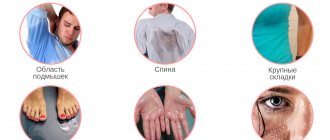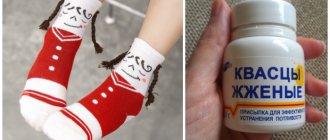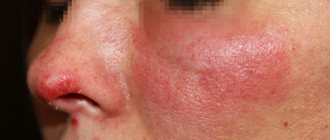Hyperhidrosis is increased sweating.
Normally, our body secretes 400–600 ml of sweat per day. In the heat, during physical activity, visiting a sauna, drinking hot drinks, or experiencing stress, this volume increases significantly. After the action of the provoking factors ceases, the sweat glands turn off and the person stops sweating. This is a natural physiological process. But disturbances in it lead to the fact that the palms, face, and armpits become wet for no apparent reason. People with hyperhidrosis sweat even when not physically active. For example, when sitting under air conditioning or swimming in a pool.
What is hyperhidrosis
A person has 2 types of sweat glands, which differ in their functions and regulatory mechanisms:
- Apocrine glands - most of them are located in the armpits and around the external genitalia, regulated by the sympathetic nervous system, adrenergic fibers, where the main substance is adrenaline. They begin to function in adolescence, produce a secretion with pheromones - an individual smell; under stress, the function increases, but they do not participate in thermoregulation.
- Eccrine glands - the largest number - are located in the armpits, on the feet and palms, and secrete the liquid part of sweat. The main regulator of the function is acetylcholine. The glands are involved in thermoregulation and sweating during stress.
The work of the vegetative unequal system, which controls the sweat glands, is not controlled by consciousness. Therefore, it is impossible to cause increased sweating on your own; it increases in response to an increase in body temperature during illness, in hot weather or after physical activity. Sweating increases with excitement, emotional stress, which leads to the release of adrenaline.
But the condition of hyperhidrosis is different from normal sweat production. The glands work actively when a person is calm and does not overheat. This is often associated with various pathologies. There is diffuse hyperhidrosis, in which sweating increases throughout the body. The disease is often associated with pathology of the nervous system. Local, or focal hyperhidrosis, affects only one area of the body. This form is more common than others.
Sweating may be seasonal and occur only in the hot season, but for most people with pathology it does not depend on the season.
Folk remedies
In the treatment of hyperhidrosis in the armpit area, traditional treatment methods are widely used. The effect of such methods is aimed at naturally reducing sweat production and eliminating unpleasant odors.
The most commonly used:
- Sage - the action of the herb allows you to restore the normal functioning of the ducts and reduce the development of harmful microorganisms. The plant is used in two ways. Inside - pour a tablespoon of dry plant with a glass of boiling water and leave for 20 minutes. Take the resulting liquid throughout the day. The second way to use herbs for baths and lotions is to prepare a strong decoction of the herbs and wipe the armpit area twice a day with a cotton pad. The duration of treatment is carried out until the discomfort decreases.
- Lemon – allows you to refresh the skin and reduce unpleasant odor, apply several times a day. At the same time, it does not cause unpleasant symptoms of itching and burning. To use, rub the skin in the armpit area with a slice of lemon, after cleansing it with cool water.
- Chamomile is used to treat hyperhidrosis in various areas of the skin. You need to prepare a strong chamomile decoction, brew three tablespoons of flowers in two glasses of water. Strain the resulting broth and cool to room temperature. Add a teaspoon of soda to the liquid and mix well. Wipe the armpit area three times a day.
- Baths with added salt - you must use sea salt without any additives. Salt allows you to remove excess fluid and normalize work in the glands. Add 50 grams to the bath. salt and completely dissolve. It is recommended to take within 20 minutes, the water should be at room temperature.
- Tar soap - take a shower or bath twice a day using tar soap. Bathing water should be at room temperature. Soap eliminates unpleasant odors and reduces the proliferation of harmful microorganisms.
- Oak bark decoction - the product has tanning properties and helps normalize sweat secretion in the armpits. Pour a tablespoon of the dry component into a glass of boiling water and leave for 20 minutes, wipe the armpit area daily and add to the water while bathing.
- Baking soda has the property of reducing sweat production and eliminating unpleasant odors; regular use of baking soda also has antiseptic properties and cleanses pores of impurities. While taking a bath, it is necessary to wipe the armpit area with a small amount of baking soda, and then rinse with laundry soap.
The use of traditional treatment methods allows you to achieve a temporary result; only specialized procedures can eliminate the cause of such discomfort.
To obtain visible results, it is necessary to regularly carry out treatment using traditional methods. Before starting therapy, it is necessary to conduct a test for individual sensitivity to the components.
Causes of excessive sweating
Patients most often turn to dermatologists with the primary form of pathology, for which it is impossible to establish the cause. The first symptoms of hyperhidrosis appear during puberty. In girls and boys, this is associated with increased activity of the hormones testosterone and cortisol and immaturity of the nervous system. Daily sweat production becomes strong, activity increases in all types of sweat glands. This is why body odor increases in teenagers.
It is believed that primary hyperhidrosis in 30-50% of patients is associated with hereditary factors. But the first symptoms may appear at the age of 20-30 years. They are provoked by chronic stress, hormonal changes and other reasons. The secondary form of excessive sweating of the armpits is associated with the following conditions:
- excitability and high activity of the autonomic nervous system;
- endocrine pathologies, most often the state of hyperthyroidism, insulin resistance in diabetes mellitus;
- diseases of the cardiovascular system, accompanied by cardiac arrhythmias and rapid heartbeat;
- some types of malignant and benign tumors;
- metabolic disorders and excess body weight;
- overdose or side effects of drugs affecting the autonomic nervous system.
It is not always possible to determine the cause of excessive sweating. But it helps to effectively combat sweating.
Sweaty armpits in women
In the female body, the release of large amounts of sweat depends on hormonal levels. When it changes, the interaction of various parts of the autonomic nervous system changes. This process is most pronounced during menopause.
With a decrease in ovarian function in women, their stimulation by pituitary hormones - follicle-stimulating and luteinizing hormones - increases. But due to physiological characteristics, the release of thyroid-stimulating hormone, which increases blood flow in the thyroid gland, simultaneously increases. Most often this process starts in the evening or at night. It manifests itself in the form of hot flashes - the appearance of a feeling of heat in the upper body and head. The woman begins to sweat heavily. The duration of such an attack is several minutes.
You are more likely to experience heavy sweating if you are overweight. Thermoregulation disorders appear with arterial hypertension. These diseases also often progress after age 50. Hyperhidrosis in this case is secondary. It is not life-threatening, but causes discomfort.
Types of electrophoresis
Using electrophoresis procedures, medications penetrate deeper, which reduces sweat production in the armpits.
The essence of the procedure for treating hyperhidrosis in the armpit area is the effect of a small amount of current on the skin; no tests are required before starting the procedure.
Varieties of electrophoresis are used depending on the complexity and location of hyperhidrosis. The individual characteristics of the person and the degree of sensitivity to the procedure are also of great importance.
To use electrophoresis, it is necessary to prepare a special solution, which can be of several types:
- saline;
- distilled water;
- dimexide.
A specialist will help you choose the right type of solution; to achieve visible results, it is recommended to carry out at least 10 procedures.
Underarm sweating in men
The functioning of the male body is regulated by the hormone testosterone. It performs an anabolic function and accelerates metabolism. Sensitivity to adrenaline is also higher in men. Therefore, small bursts of this hormone speed up the heart rate, increase reaction speed and lead to sweaty armpits.
A man may sweat more than usual if he prefers hot and spicy foods. Sweating of the armpits and the entire body greatly increases when drinking alcoholic beverages. In this case, hyperhidrosis is associated with metabolic processes, as the body removes toxic substances after recycling ethanol. Nicotine has a direct stimulating effect. It increases the synthesis of acetylcholine, which enhances the work of the sweat glands. Therefore, sweating is a natural phenomenon in men who smoke.
Sweating occurs when there is severe nervous tension. Men's jobs are more likely than women's to involve stress or hazardous activities.
Men are susceptible to developing obesity, metabolic disorders and hypertension. Those at risk are those who lead a sedentary lifestyle and have a large waist circumference at the age of 45-50. These disorders affect the tone of the sympathetic nervous system and sweating.
Diagnostics
The cause of general hyperhidrosis is determined by a general practitioner or family doctor. The diagnostic search is aimed at identifying primary disorders of the body, which can be manifested by profuse sweating. For examination, modern laboratory tests and various instrumental visualization methods are used. The most informative ones are:
- Specific tests
. To assess the amount of sweating, there are quantitative diagnostic methods - gravimetry and evapometry. Hyperhidrosis is established when secretion exceeds 20 mg/minute. Qualitative methods are suitable for assessing the area of pathological sweating; the Minor test and the ninhydrin test are used. - Blood tests
. Tests for the main hormones are required: thyroid, corticosteroids, tropic substances of the anterior pituitary gland. In women, the levels of estrogen and progesterone are examined. To identify the cause of the inflammatory process, clinical and biochemical blood tests and a proteinogram should be studied. - Bacteriological analysis
. To confirm the presence of infectious pathogens, culture of blood, throat swabs or sputum is performed on selective nutrient media. Serological tests are effective for detecting antibodies to pathogenic microorganisms in plasma. To detect brucellosis, the Burnet allergy test is informative. - X-ray examination
. X-ray of the chest is necessary to exclude tuberculous or oncological processes. X-rays are used to look for suspicious space-occupying formations and changes in the vascular pattern. For a more detailed study of the lungs and mediastinum, a CT scan of the chest cavity and MRI are recommended. - Invasive methods
. In case of detection of formations in the chest cavity, transthoracic biopsy (TTB) and subsequent cytomorphological examination are indicated to exclude malignant processes. If the lymph nodes are enlarged, a biopsy of the pathological formation is performed.
When to see a doctor
If a person begins to sweat during exercise, hot weather, or extreme excitement, there is no reason to worry. Health problems are indicated by sweating, which occurs against a background of complete calm or is accompanied by additional symptoms.
A slightly elevated body temperature, which is accompanied by night or evening sweats, may be a sign of a chronic infection. Sometimes this is how pulmonary tuberculosis, immune disorders, and the initial stages of cancer manifest themselves.
A dangerous symptom is the appearance of weakness, dizziness, loss of consciousness against the background of increased sweating. This may be a sign of low glucose levels - hypoglycemia. The condition is life-threatening and therefore requires emergency medical attention. Hyperhidrosis is cured only after glucose levels are normalized.
Older women who experience menstrual irregularities and the first symptoms of approaching menopause require special treatment. Without special means, the condition may gradually worsen, and menopause will be difficult.
Increased sweating is one of the signs of thyrotoxicosis. This disease is accompanied by an increase in thyroid function and the release of increased doses of hormones into the blood. At the same time, the heartbeat increases, heart rhythm disturbances appear, and the person quickly loses body weight, despite maintaining the nature of the diet.










